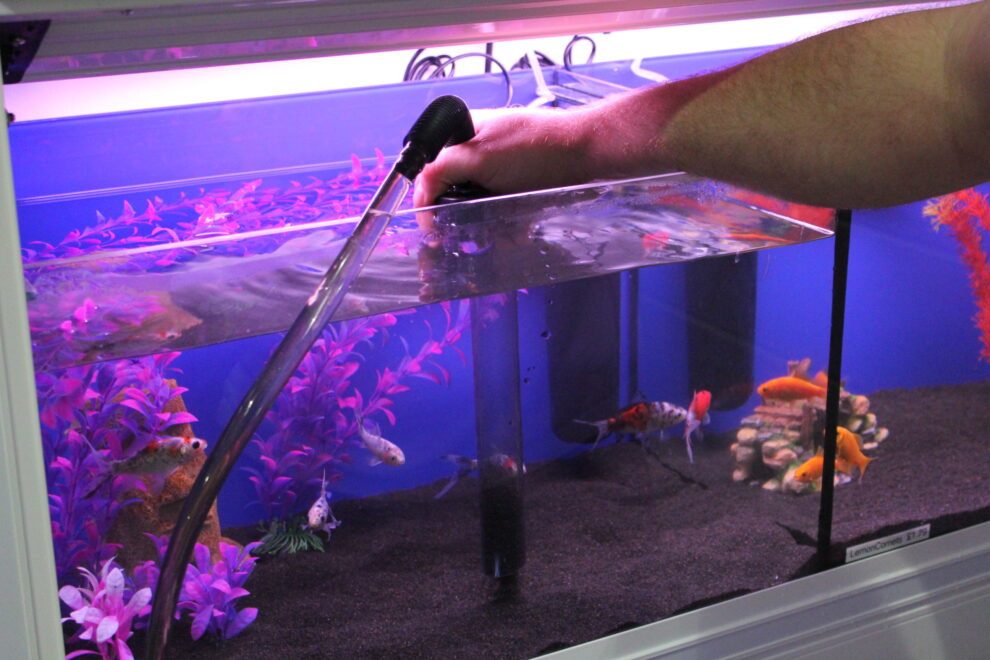How Often Should You Change Water In A 20 Gallon Fish Tank
Fish pollute water as they breathe and defecate, merely they are not adapted to live in their own waste. The but way us fishkeepers go away with keeping fish in aquariums is past way of biological filtration, and h2o changes. Without these fish would be poisoned by the h2o they live in and dice.
Filters colonise with beneficial bacteria which convert toxic ammonia excreted by fish beginning into nitrite (also toxic,) and so into nitrate. The easiest fashion to deal with nitrate is to remove it via a water change. Nitrate is constantly building up in your aquarium (because its a byproduct of biological filtration,) so if you remove a percentage of tank water with new water (with a lower level of nitrate,) the nitrate level will come downward.
Change water frequently and although tap water contains some nitrate, it's unremarkably lower than the level in the tank. Test your tap h2o and tank water for nitrate. Aim to go along tank water at 40 parts per million or less. To do this your tap water will need to be below 40ppm, and ideally below 10ppm. If the tap water nitrate level is high, consider conducting water changes with Reverse Osmosis water instead, which is purified.
Water should too be changed to lower phosphate levels, remove tannins and staining, and to buffer pH and KH. Fish tend to abound faster in tanks which are water-changed regularly, and so a water change may besides be removing growth-inhibiting hormones, which don't build up in rivers in the wild.
So the frequency of water changes should exist based around the nitrate level in the h2o. A depression nitrate level and technically your water shouldn't need irresolute, although a change does benefit in the other ways too listed above.
Never remove all of the tank h2o in a water alter, and little and often is all-time. Set yourself a authorities and stick to it. Remember that filter media should simply be cleaned in old tank h2o so water change time is the perfect fourth dimension to combine filter cleaning. The mucky water tin then be used to water your plants.
Start with a routine of a 25% water change every two weeks. If that keeps the nitrate level low, stick to the regime or you can even supersede slightly less. If nitrate levels withal climb, you need to change more water at a time, like xxx%, or more frequently, like weekly.
If you dechlorinate properly and always bring water to the same temperature, there is actually no limit on how oftentimes you can alter the water. Professional person fish breeders may alter h2o daily in club to remove excess food and encourage maximum growth.
But if you don't change the water often enough the nitrate level will rise, pH and KH will drop, and you'll get something chosen Old Tank Syndrome, whereby pH drops and then low the biological filter stops working properly, your hardy fish but near survive it only newly purchased fish die within hours or days of existence added.

How to do a h2o change
To do a h2o change you will demand a syphon tube and a saucepan. You aren't meant to start the syphon past sucking the pipe for hygiene reasons, so instead await for one which can be started by paw. Place ane end of the tube in the tank, the other end in the bucket on the flooring, beginning the syphon and you are away. Keep an eye on the tank terminate to ensure no small fish are sucked downward the pipe, and the bucket end to brand sure it doesn't overflow.
Discard the dirty tank water and take the bucket to the sink. Fill with common cold water, a lilliputian scrap of warm water and check the temperature to make certain it'south the same as in the tank. Add together liquid dechlorinator every bit directed, swirl it effectually by hand and then leave for a infinitesimal. Cascade the water back into the tank and your water change is washed. If the water removed causes the pump to run dry, plough the pump off before the h2o alter and dorsum on after.
Water alter with gravel make clean
Buy an aquarium syphon tube and it volition near always come with a wide bore gravel cleaning attachment. Gravel vacs are great because you go the opportunity to clean your gravel while also conducting a h2o alter. Uneaten food and fish poo builds upwardly in aquarium gravel and tin harbour nitrate, so information technology's best removed.
Choose a gravel cleaner that suits your size of the tank. As well modest and information technology will take a long time to remove water. Too large and information technology may non fit in under the tank lid, may struggle to starting time syphoning, and it will remove water too quickly, elimination the tank.
Other ways to practice a h2o modify
In small nano tanks, you could simply use a one-litre measuring jug. You know its book and it's very quick and easy. In huge fish tanks, you could literally bail h2o out using a bucket, although it's difficult concrete work.
If you don't desire to put your back out you could simply pump water from the tank. Connect an aquarium powerhead or pump to a long hose and put the other end of the hose out in the garden or down a drain. Merely make sure you don't forget and pump all the water out, or that an unprotected pump intake doesn't suck in your fish.
Source: https://www.swelluk.com/help-guides/how-often-should-you-change-the-water-in-a-tropical-fish-tank
Posted by: holtvared1955.blogspot.com


0 Response to "How Often Should You Change Water In A 20 Gallon Fish Tank"
Post a Comment